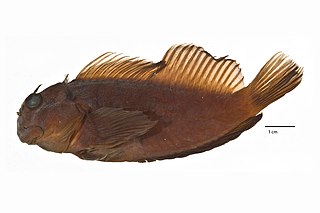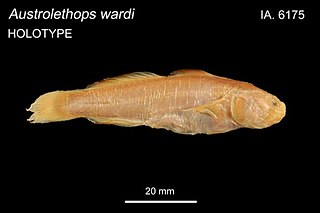The Mitchell gudgeon is a species of fish in the family Eleotridae endemic to the Kimberley region of Australia, where it is only known from the Mitchell River system. This species can reach a length of 4 cm (1.6 in). The specific name honours the ichthyologist J. Barry Hutchins of the Western Australian Museum, who collected the type.
Cirripectes alleni, the Kimberley blenny, is a species of combtooth blenny found in coral reefs in the eastern Indian Ocean, around Australia. This species reaches a length of 6.5 centimetres (2.6 in) TL. The specific name honours the ichthyologist Gerald R. Allen.

Cirripectes gilberti is a species of combtooth blenny found in coral reefs in the Indian Ocean. This species reaches a length of 9.3 centimetres (3.7 in) SL.
Cirripectes jenningsi is a species of combtooth blenny found in the Pacific Ocean, from the Gilbert Islands to the Tuamotu Islands. This species reaches a length of 7.6 centimetres (3.0 in) SL. The specific name honours the Alexander Jennings who was the manager of Swains Island, one of the Phoenix Islands in American Samoa, where Schultz collected the type.

Cirripectes randalli is a species of combtooth blenny found in the western Indian Ocean. This species reaches a length of 10.7 centimetres (4.2 in) SL. The specific name honours the American ichthyologist John E. Randall of the Bishop Museum in Honolulu.
Cirripectes springeri, Springer's blenny or the spotted eyelash blenny, is a species of combtooth blenny found in coral reefs in the western Pacific Ocean. This species reaches a length of 10 centimetres (3.9 in) TL. The specific name honours the American ichthyologist Victor G. Springer of the United States National Museum who has worked extensively on blennies.
Istiblennius muelleri, Mueller's rockskipper, is a species of combtooth blenny found in the western Pacific ocean. Males of this species can reach a maximum of 7 cm (2.8 in) SL, while females can reach a maximum of 5.5 cm (2.2 in) SL. The specific zoology honours the German-Australian physician, geographer, and botanist Ferdinand von Mueller (1825-1896).
Mimoblennius cas is a species of combtooth blenny found in the western Indian Ocean, around Comoros. This species grows to a length of 3.2 centimetres (1.3 in) SL. The specific name is an acronym which stands for the California Academy of Sciences where the holotype and paratypes are retained.

Omobranchus germaini, Germain's blenny, is a species of combtooth blenny found in coral reefs in the western Pacific ocean.
Petroscirtes thepassii, the Thepas' sabretooth blenny or the Thepas' fangblenny, is a species of combtooth blenny found in the western central Pacific ocean. This species reaches a length of 5.9 centimetres (2.3 in) SL. The specific name of this blenny honours the collector of the type, the military surgeon A.H. Thepass.

Ecsenius alleni, known commonly as the Allen's blenny, is a species of combtooth blenny in the genus Ecsenius. It is found in coral reefs in the eastern Indian Ocean, specifically in western Australia. It can reach a maximum length of 3.4 centimetres. The blennies feed primarily off of plants and algae. The specific name honours the ichthyologist Gerald R. Allen.
Tanyemblemaria alleni, the slender blenny, is a species of chaenopsid blenny found around Panama, known from one species collected at Isla del Rey. It can reach a length of 5.4 centimetres (2.1 in) TL. The specific name honours the collector of the type, Gerald R. Allen of the Western Australia Museum in Perth.
Emblemariopsis bottomei, the shorthead blenny or the midnight blenny, is a species of chaenopsid blenny found in coral reefs in the western central Atlantic ocean. It can reach a maximum length of 3 centimetres (1.2 in) SL. The specific name honours Peter Bottome, although who this is, is not specified but it may possibly be the Venezuelan businessman Peter Bottome Deery (1937-2016).
Emblemariopsis dianae, the orangeflag blenny, is a species of chaenopsid blenny found in coral reefs around Belize, in the western central Atlantic ocean. It can reach a maximum length of 2.1 centimetres (0.83 in) fish measurement. The specific name honours Diane M. Tyler, a researcher into the behavioural ecology of blennies in the family Chaenopsidae and the wife of James Chase Tyler.
Ophiclinus gabrieli, the Frosted snake-blenny, is a species of clinid native to Amphibolis seagrass in the coastal waters of southern Australia. It can reach a maximum length of 16 centimetres (6.3 in) TL. The specific name honours the Australian pharmacist and conchologist Charles John Gabriel (1879-1963), the collector of the type.
Enneapterygius larsonae, known commonly as the Western Australian black-head triplefin, is a species of triplefin blenny in the genus Enneapterygius. It was described by the German ichthyologist Ronald Fricke in 1994. The specific name honours Helen K. Larson, the Curator of Fishes at the Museum and Art Gallery of the Northern Territory in Darwin, Australia, who collected the type.

The Posidonia clingfish is a species of clingfish native to the Australia coast. This species grows to a length of 2 centimetres (0.79 in) SL. Pale green to pale blue with fine spots forming dark reticulations on back and sides, larger blue spots often on back, and a pinkish to brown line from snout to gill cover. The posidonia clingfish is endemic to southern Australia where its range extends from Corner Inlet in Victoria west as far as Rottnest Island in Western Australia. It occurs down to a depth of 10 metres (33 ft) where it is found on macroalgae and within seagrass beds, its favoured substrate to adhere to is the leaves of the sea grass Posidonia australis. This species is the only known member of its genus and was described by John C. Briggs in 1993 with a type locality of Fiddler's Bay which is 16 kilometres south of Tamby Bay in South Australia. Briggs gave the species the specific name hutchinsi in honour of the ichthyologist Barry Hutchins of the Western Australia Museum in Perth, Western Australia.
Gerald Robert "Gerry" Allen is an American-born Australian ichthyologist. His career began in 1963, when he spent a semester at the University of Hawaii, where he also received a PhD in marine zoology in 1971. In 1972, Allen wrote his doctoral thesis on the systematics and biology of the anemone fish.

The small-eyed goby is a species of goby native to tropical reefs of the Indian Ocean through the western Pacific Ocean where it inhabits areas of coral rubble. As its common name suggests, this species has particularly small eyes. This species grows to a length of 6 centimetres (2.4 in) TL. This species is the only known member of its genus. The small-eyed goby is specialised to feed on seagrass and they share a burrows with mud lobsters of the genus Thalassina. The specific name honours Charles Melbourne Ward (1903-1966), the Australian actor, naturalist and collector of specimens who collected the type specimen.
Cirripectes heemstraorum, the yellowtail blenny, is a species of combtooth blenny from the family Blenniidae. It is found in the Indian Ocean where it is known from three South African specimens and an Indonesian specimen. It is distinguished from its congeners by the nape having an extensive black flap on both sides of its neck; 10-13 cirri which are found between the neck flaps; an entire dorsal fin; 5-6 cirri above the eye, 6-8 cirri on the nose; the males have small dark spots on their body towards the tail which merge to form short black stripes on caudal peduncle, in life the females have a brilliant yellow caudal fin while in the males only the outer half of the tail is bright yellow.






